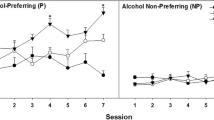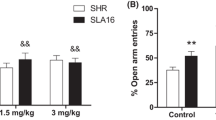Abstract
The motor impairing effects and plasma concentrations of barbital and lorazepam were studied in the alcohol tolerant (AT) and alcohol non-tolerant (ANT) rat lines developed for low and high sensitivity to motor impairment from ethanol. The mixed (M) line, from which the AT and ANT rats were derived, was also included in the study. Like ethanol, barbital and lorazepam impaired the performance of the ANT rats more than that of the AT rats. The motor performance of the M rats was relatively more impaired after barbital than after lorazepam administration at the same dose used in the AT and ANT rats. At the two latter time points (2.5 and 3.5 h) the sensitive ANT rats had significantly higher serum barbital concentrations than the AT rats. The serum barbital concentrations of the AT and ANT rats did not differ, however, at the two first time points (0.5 and 1.5 h) of the tilting plane tests, although the ANT rats were significantly more intoxicated. The concentrations of lorazepam in plasma do not explain the differential motor impairment either, since the sensitive ANT rats had lower plasma concentrations than the insensitive AT rats. The results, thus, suggest that the selection involved in the development of the AT and ANT lines has not been specific for ethanol. The results also support the idea that ethanol, barbiturates and benzodiazepines have some modes of action in common.
Similar content being viewed by others
References
Alpern HP, McIntyre TD (1984) Are short sleep and long sleep mice specifically sensitive to alcohol? Neurosci Abstr 10:968
Alpern HP, McIntyre TD (1985) Evidence that the selectively bred long-and short-sleep mouse lines display common narcotic reactions to many depressants. Psychopharmacology 85:456–459
Arvola A, Sammalisto L, Wallgren H (1958) A test for level of alcohol intoxication in the rat. QJ Stud Alcohol 19:563–572
Bass MB, Lester D (1979) Rats bred for ethanol sensitivity: impairment of swimming by ethanol and pentobarbital. Psychopharmacology 63:161–167
Dudek BC, Abbott ME, Phillips TJ (1984) Stimulant and depressant properties of sedative-hypnotics in mice selectively bred for differential sensitivity to ethanol. Psychopharmacology 82:46–51
Eriksson CJP, Sarviharju M (1984) Motor impairment, narcosis and hypothermia by ethanol: Separate genetic mechanisms. Alcohol 1:59–62
Eriksson K, Rusi M (1981) Finnish selection studies on alcohol-related behaviors: General outline. In Development of animal models as pharmacogenetic tools, Proc Workshop Boulder, Colorado 1978, Rockville: NIAAA Research Monograph-6, pp 87–117
Erwin VG, Heston WDW, McClearn GE, Deitrich RA (1976) Effect of hypnotics on mice genetically selected for sensitivity to alcohol. Pharmacol Biochem Behav 4:679–683
Howerton TC, O'Connor ME, Collins AC (1983) Differential effects of long chain alcohols in long- and short-sleep mice. Psychopharmacology 79:313–317
Hunt WA (1983) The effect of ethanol on GABAergic transmission. Neurosci Behav Rev 7:87–95
Khanna JM, Le AD, Kalant H, Kim C (1985) Differential sensitivity to ethanol, pentobarbital, and barbital in spontaneously hypertensive and normotensive Wistar-Kyoto rats. Psychopharmacology 86:296–301
Least CJ, Johnson GF, Solomon HM (1977) Micro-scale anticonvulsant assay with the use of nitrogen phosphorus detector and on-column methylation with a macro-scale procedure involving flame-ionization detection. Clin Chem 23:593–595
Lester D, Lin GWJ, Anandam N, Riley EP, Worsham ED, Freed EX (1977) Selective breeding of rats for differences in reactivity to alcohol: an approach to an animal model of alcoholism IV. Some behavioural and biochemical measures. In: Thurman RG, Williamson JR, Drott HR, Chance B (eds) Alcohol and aldehyde metabolizing systems, vol 3. Academic Press, New York, pp 635–642
McClearn GE, Kakihana R (1981) Selective breeding for ethanol sensitivity: SS and LS mice. In: Development of animal models as pharmacogenetic tools, Proc Workshop Boulder, Colorado 1978. Rockville: NIAAA Research Monograph-6, pp 147–159
McIntyre TD, Alpern HP (1983) The interaction of CNS depressants and GABAergic drugs in mice selectively bred for the narcotic effects of ethanol. Neurosci Abstr 9:130
McIntyre TD, Alpern HP (1985) Reinterpretation of the literature indicates differential sensitivities of long-sleep and short-sleep mice are not specific to alcohol. Psychopharmacology 87:379–389
Mayer JM, Khanna JM, Kalant H, Chau A (1982) Factors involved in the differential response to ethanol, barbital and pentobarbital in rats selectively bred for ethanol sensitivity. Psychopharmacology 78:33–37
Olsen RW (1982) Drug interactions at the GABA receptor-ionophore complex. Annu Rev Pharmacol Toxicol 22:245–277
Reynolds JEF, Prasad AB (eds) (1982) Martindale The Extra Pharmacopoeia: The Pharmaceutical Press, London
Riley EP, Freed EX, Lester D (1976) Selective breeding of rats for differences in reactivity to alcohol: an approach to an animal model of alcoholism I. General procedures. J Stud Alcohol 37:1535–1547
Riley EP, Lochry EA, Freed EX (1978) Differential tolerance to pentobarbital in rats bred for differences in alcohol sensitivity. Psychopharmacology 58:167–170
Riley EP, Shapiro NR, Lochry EA (1979) Hypnotic susceptibility to various depressants in rats selected for differential ethanol sensitivity. Psychopharmacology 60:311–312
Sanders B, Sharpless SK, Collins AC, McClearn GE, Flanagan C (1978) Activating and anesthetic effects of general depressants. Psychopharmacology 56:185–189
Sinclair JD, Rusi M, Airaksinen MM, Altshuler HL (1982) Relating TIQ's, opiates, and ethanol. In: Bloom FE, Barchas J, Sandler M, Usdin E (eds) Beta-carbolines and tetrahydroisoquinolines. Alan R Liss, New York, pp 365–376
Author information
Authors and Affiliations
Rights and permissions
About this article
Cite this article
Hellevuo, K., Kiianmaa, K., Juhakoski, A. et al. Intoxicating effects of lorazepam and barbital in rat lines selected for differential sensitivity to ethanol. Psychopharmacology 91, 263–267 (1987). https://doi.org/10.1007/BF00518174
Received:
Revised:
Issue Date:
DOI: https://doi.org/10.1007/BF00518174




